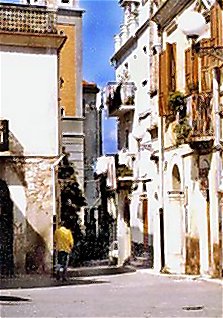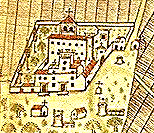Ascoli
Ascoli Satriano is a small 'city' in Puglia, located on the south-western fringes of the Tavoliere, south Italy's largest plain. During the period 1700 - 1990 this area was subject to rapid, often turbulent economic change - from transhumant pastoralism, to large estates and later land reform. Against this background, this project examines changes in kinship and family forms and in marriage and inheritance strategies.
The Project
In recent years, by far the most innovative analysis of Italian kinship and marriage systems has come from annales and micro-historians (e.g. Delille 1988, Levi 1992, Raggio 1990, Quaderni Storici 1994 Vol. 29). This project seeks to offer a new synthesis of historical and anthropological materials, using a combination of archival material and ethnographic fieldwork. Ascoli was chosen partly for its fairly manageable size (pop. 2,000 : 1700; 6,800: 1994), but more especially for the high quality of its historical records. Using these archival sources, we constructed a database linking the different types of records through individuals mentioned in the texts.
The WWW Presentation
Mainly, although not exclusively, aimed at anthropologists, this
teaching package explores the main documentary research resources available to  historically-inclined anthropologists in the notarially rich cultures
of south-west Europe. Moreover, in focusing on the forms, time-spread,
limitations and circumstances of production of these sources,
implicitly at least, it calls for a more critical and sensitive
analysis, of greater time depth, than is commonly found in existing
historical-anthropological studies of south Italy that, only too
often, have taken historical sources too much at face value, and
have over-privileged a recent, much foreshortened, past.
historically-inclined anthropologists in the notarially rich cultures
of south-west Europe. Moreover, in focusing on the forms, time-spread,
limitations and circumstances of production of these sources,
implicitly at least, it calls for a more critical and sensitive
analysis, of greater time depth, than is commonly found in existing
historical-anthropological studies of south Italy that, only too
often, have taken historical sources too much at face value, and
have over-privileged a recent, much foreshortened, past.
The first section is based upon an article on kinship and neighbourhood in 18th and 20th century Ascoli. It introduces the main types of population and property sources - State of Souls, cadastral and hearth-tax records, parish registers - and seeks to illustrate the range of information they contain, and the ways they can be used in both family and wider kinship reconstruction.
The second section focuses on changes over time in inheritance, marriage and dowry patterns and, more specifically, seeks to illustrate how notarial contracts can be used to document these processes.
The final two sections are more concerned with the visual and ritual representation of urban and rural space, with the rise and fall of a southern European peasant society, and with long-term agricultural and urban change.
Documents
![]()
Throughout, we have provided specimens of both original texts
and rough translations of their contents. Our main aim, here,
is to show that commonly asserted anthropological fears about
the palaeographic difficulties associated with the use of 16th
- 18th century records are greatly over-stated. The most significant
problems in employing historical materials are in understanding
the context and methods of their creation.
The Ascoli Project is the work of:
- Dr. Nevill Colclough ntc@ukc.ac.uk
- Dr. Janet Bagg j.bagg@ukc.ac.uk
- Ms. Jean Hosking
- Ms. Ripalta Coluccelli